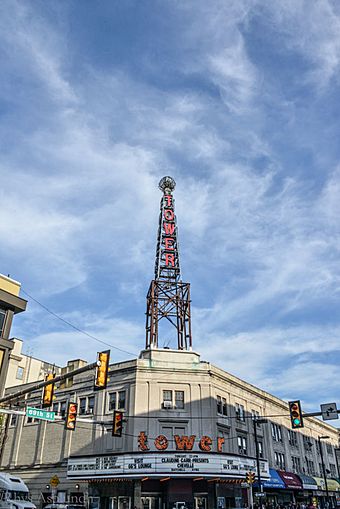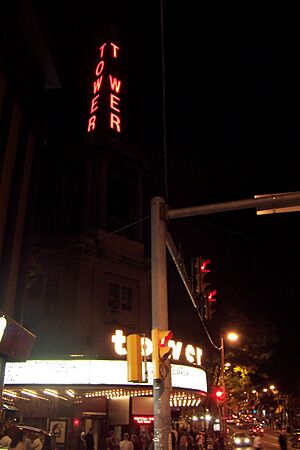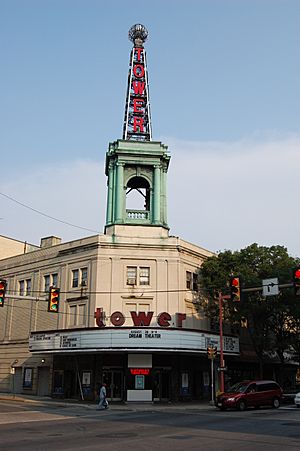Tower Theater (Pennsylvania) facts for kids

The Tower Theater in August 2014
|
|
| Location | 69th and Ludlow Streets Upper Darby Township, Pennsylvania, U.S. |
|---|---|
| Type | Indoor music theatre |
| Seating type | Reserved |
| Capacity | 3,119 |
| Opened | 1927 |
The Tower Theater is a famous music venue in Upper Darby Township, Pennsylvania, which is a suburb of Philadelphia. It first opened its doors in 1927. Since the 1970s, it has become a popular place for musicians from all over the world to perform. In 2018, Rolling Stone magazine even named it one of the ten best live music venues in the United States.
The theater is well-known for its amazing sound quality, which makes music sound great inside. This is why many bands have chosen to record live albums there. The building is located in the Terminal Square area of Upper Darby, right next to the 69th Street Terminal.
History
From Movie House to Music Hall
The Tower Theater was built in 1927 and opened a year later. It was one of the first movie theaters in Upper Darby. In its early days, the theater showed both movies and live stage shows called vaudeville acts. It was located in a very busy area just outside of Philadelphia.
By the 1970s, the theater was no longer as popular and was showing older movies for just $1. But in 1972, a company called Midnight Sun Concerts fixed up the theater after a fire and started holding concerts there. The very first show, featuring Dave Mason and Buzzy Linhart, was completely sold out. It was a huge success and marked the beginning of the Tower's new life as a legendary music hall.
A Stage for Stars

The Tower Theater quickly became the place where many famous musicians were introduced to American audiences. In 1972, David Bowie and the band Genesis played some of their first shows in the United States at the Tower.
In September 1974, Bruce Springsteen and his new E Street Band played at the theater. It was a big moment in his career. He returned for two more sold-out shows later that year, long before he became a global superstar.
Many other famous artists and bands performed at the Tower, including Jackson Browne, Lou Reed, Steve Miller, Kiss, and Stevie Wonder. The sound was so good that some artists recorded live albums there. David Bowie recorded his famous David Live album during a series of shows at the Tower in 1974.
Irish rock band Thin Lizzy recorded their live album Still Dangerous at the theater in 1977. In 1980, a concert by Paul Simon was recorded and later released as an album. Even the famous musician Prince performed at the Tower twice, in 1982 and 1997.
Throughout the 1980s and 1990s, the theater hosted many different kinds of music, from rock bands like Jethro Tull and Pat Benatar to metal bands like Anthrax.
The Tower Theater Today
In the 21st century, the Tower Theater remains an important and active concert venue. It is operated by Live Nation and continues to host popular musicians and bands, much like the famous Beacon Theatre in New York City.
In 2019, the decorative tower on top of the building's sign had to be removed because of safety concerns. The ball and letters from the tower were saved and are planned to be given to a local museum.


